No doubt about it. It’s been a heck of a year.
I was on the road every month in 2013, barely having enough time between excursions to un-pack and re-pack before heading out again.
My peregrinations this year: Japan-Singapore-Sri Lanka-Japan-Los Angeles-Baja-LA-Japan-Singapore-Perth-Singapore-Sri Lanka-Singapore-Japan-Tahiti-Japan-Seattle-Nantucket-Seattle-The Great White North eh (that’s Canada, in case you’re not fluent in Canada-speak)-Seattle-Japan-Singapore-Tonga-Singapore-Japan-Hokkaido (in Japan)-Palau-and finally, back to Japan to collapse. Whew.
Fortunately, the non-stop schlepping of gear and my exhausted body around the world paid off, as the past 12 months have been fantastically productive photographically.
Many of my favourites images from this year are of cetaceans, a handful of which follow, in no particular order.
First up is a portrait of a blue whale, probably the Balaenoptera musculus brevicauda sub-species, which is often referred to as the “pygmy” blue whale. Don’t let the moniker fool you though. A blue whale “pygmy” is still huge, with this individual being 20+ metres long by my estimate.
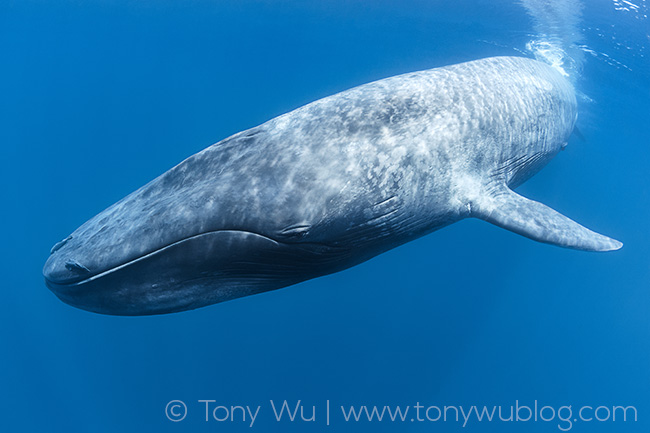
Taking a peek at the other end of a cetacean, below is a rear view of Bryde’s whale (Balaenoptera edeni), which obviously had some sort of encounter that left it with an easily recognisable scar on the left side of its fluke.
The whale cruised past me within touching distance, so I got a really good look at the scar. I can’t be certain, but my guess is that the injury resulted from some sort of bite.
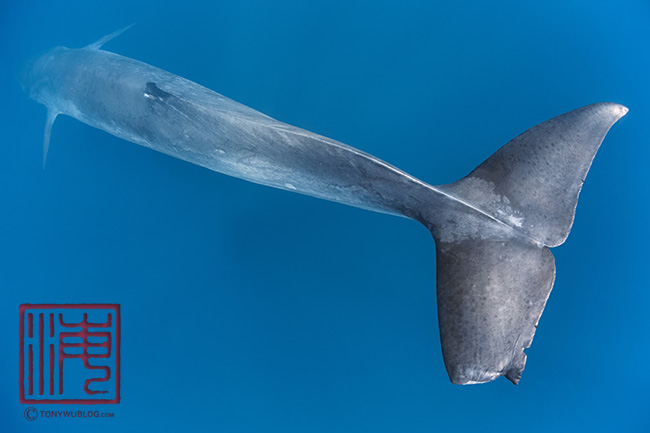
Once again this year, I had tremendous luck with sperm whales. For whatever reason, members of the Physeter macrocephalus species have been particularly generous to me over the years, permitting me many opportunities for insights into their intricate societies and behaviours.
In 2013, I entered the water when there were perhaps 100 or so around. It’s difficult to be certain of the actual number, but I counted several groups of one to two dozen at the surface simultaneously. Suffice it to say that there were a lot of whales.
The whales poo-ed on me again (how many people do you know who would voluntarily write that?!):
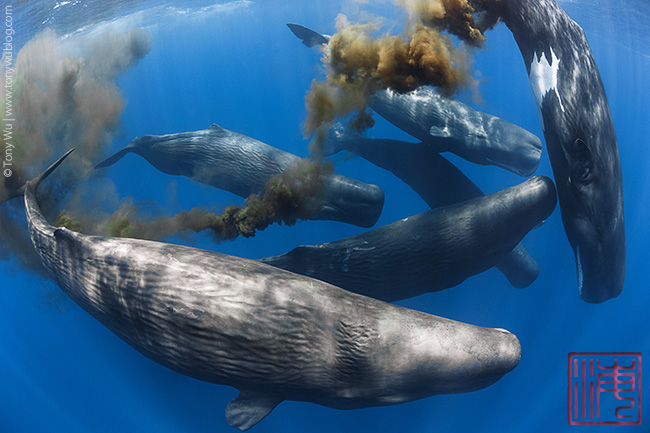
…then a bunch of them flowed around me like river water flowing around a rock, leaving me surrounded, for a moment, by hundreds of tonnes of toothed cetacean:
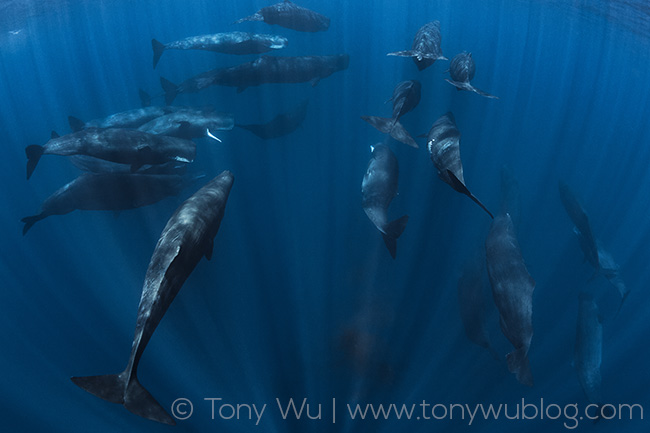
It’s a good thing I’ve had a sperm whale take my leg in its mouth before. That scared all the fear out of me.
2013 also marks my first-ever encounter with gray whales (Eschrichtius robustus). The recovery of the eastern Pacific gray whale population is a happy story, one that underscores that we can actually avoid being stupid if we try.
In short, the eastern Pacific gray whale population has rebounded from post-whaling depleted numbers, and collective concern helped to head off the potential destruction of one of the whales’ primary breeding areas in the 1990s, when Mitsubishi Corporation hatched a plan to convert part of San Ignacio Lagoon into a salt factory.
Worldwide protest and condemnation stopped it.
Possible disaster averted, the gray whale population seems healthy now, with lots of females and their energetic, inquisitive calves gathering in the waters of Baja each winter. Like many of its kin, the little gray pictured below seemed to relish interaction with people. The calf solicited, no…insisted upon, physical contact, over and over again:
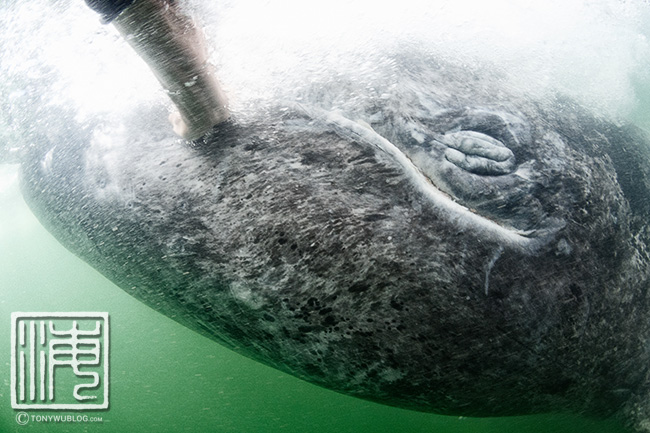
To me, this photo is a visual metaphor for how the relationship between humans and whales should always be.
I have so many photos of humpback whales (Megaptera novaeangliae) that it’s difficult just to pick one or two for a year-end summary post. But I think my favourite from the 2013 season in Tonga is probably the image below (which I used for my holiday greeting). The whale pictured is Jack, superstar humpback calf of the season, playing at the surface on a sunny day.
It’s not every year that a superstar like Jack shows up, but when we get the perfect set of circumstances, i.e., patient/ tolerant adult female + inquisitive/ super-energetic/ fun-loving calf + extended stay in the area by the mom/ calf pair, the result can be magical, as I hope the photo conveys:
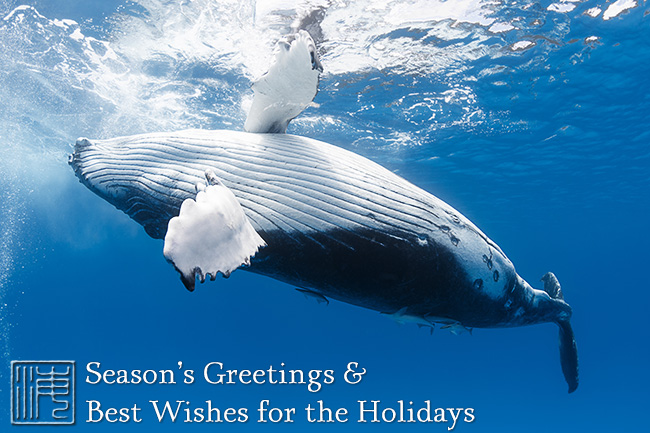
Jack embodied the joy and pleasure of being alive, sharing his limitless enthusiasm with one and all, as I’m sure everyone who was lucky enough to meet him would agree.
Bummer alert…I did have one unfortunate encounter during the year, with a blue whale that was entangled in fishing gear. It’s a long story, but after hours of observation (the whale was behaving in a strange manner), I was able to get in to take a look.
The water was super murky, so turbid in fact that I didn’t see the whale until I almost ran headfirst into it. I swam the length of its body, from head to fluke as the whale passed not two metres away from me.
Here’s part of what I saw:
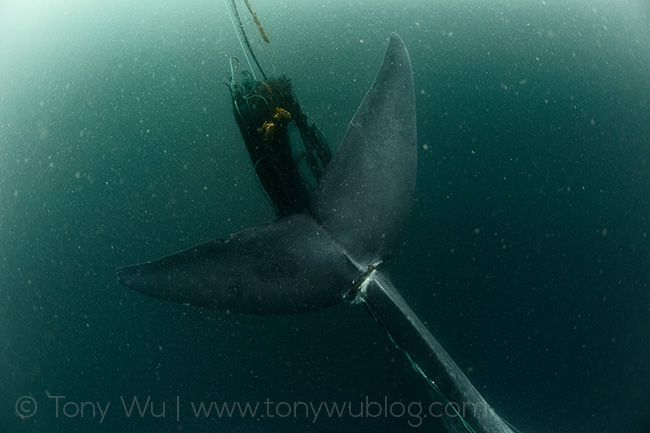
Netting wrapped completely around the whale, running through its mouth, around the pectoral fins, encircling the peduncle as shown in the image above…and trailed for many metres behind.
Even though it was heavily encumbered, the whale still swam a lot faster than I could. There was no hope of catching up to try to help. Heartbreaking. Just heartbreaking.
It’s difficult to include this among my “favourite” images for the year, but I think it’s worthwhile and appropriate to share it…as a reminder that most of the damage done to the oceans escapes our collective view and attention.
Anyway, as you can tell from the photos above, 2013 was, in a sense, a whale of a year for me (sorry, couldn’t resist).
I did, of course, have many terrific non-whale experiences, but there’s holiday food waiting, and I’m hungry, so I’m going to wrap up my final blog post for the year with this photo of a humpback whale:
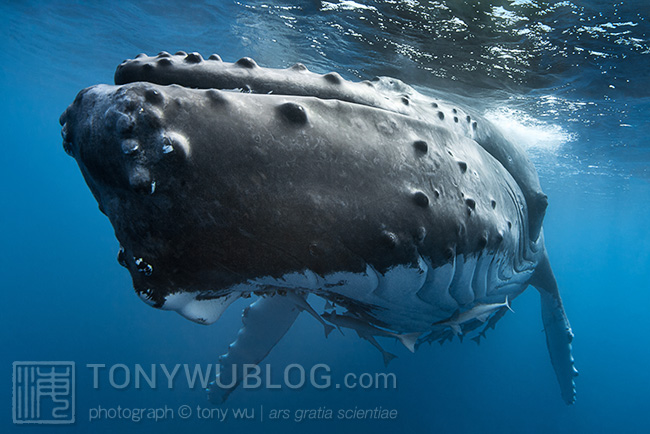
There’s a slight catch though. I didn’t take this photo in 2013. I took it in 2006, but only just got around to processing it this year. That’s how far behind I am. Sigh.
See you in 2014.